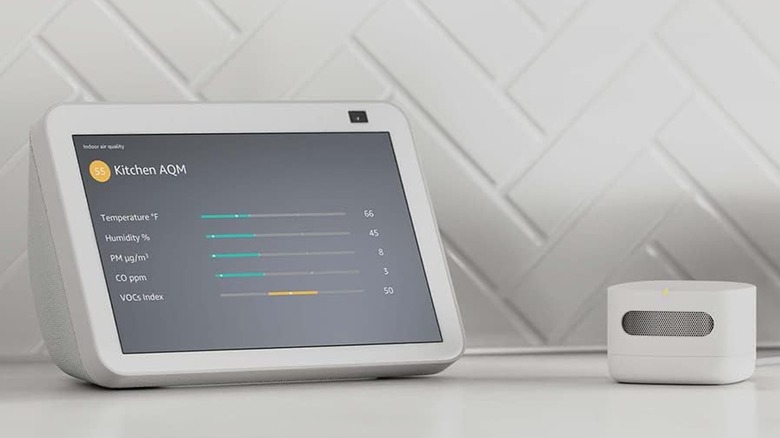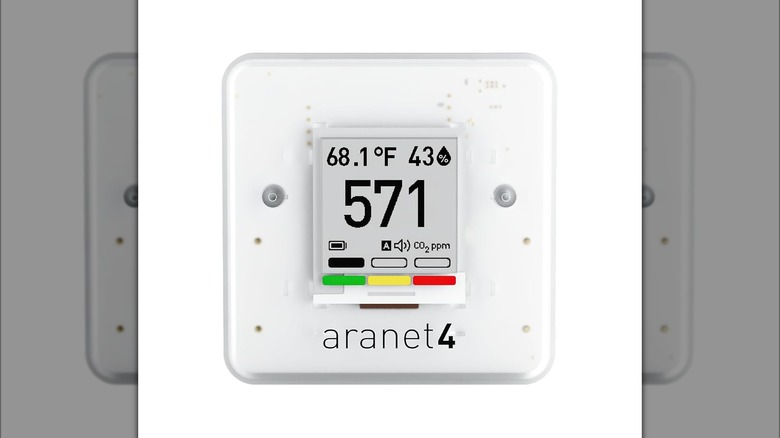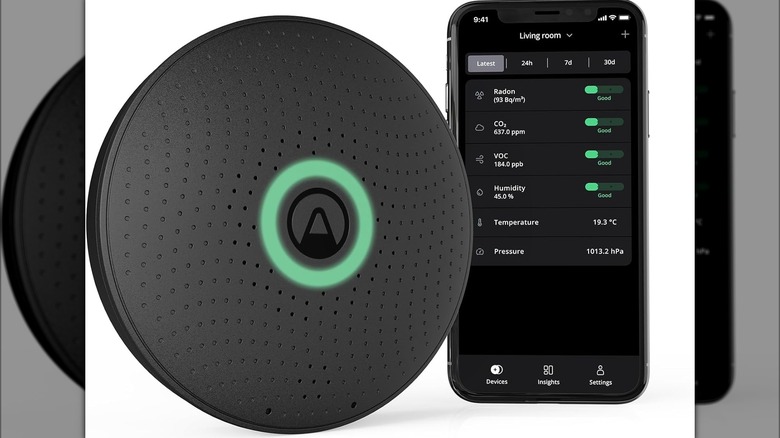4 Smart Indoor Sensors For Monitoring Your Home's Air Quality (And Why You May Want One)
We may receive a commission on purchases made from links.
Obviously, you need air to live, but how often do you spare a thought for the quality of the air you're breathing? In theory, such a thing shouldn't be necessary –- air is air, right? If you're sitting here and breathing, then that means that there's air and it's probably fine. While that is technically correct in broad strokes, you can't actually know the quality of the air you're breathing on your own, even if you're breathing it. For all you know, the air in your home is actually sub-optimal, and you've merely gotten used to it.
If you're looking to perk up the quality of the air in your home, that's a job for an air purifier, but how are you supposed to know whether an air purifier is actually effective? That's when you need to bust out a different device: the indoor air quality sensor. With the help of an indoor air quality sensor, you can get all kinds of useful information about your living conditions and, if necessary, take steps to improve them. A little more information might just make the difference between clean breathing and constant sniffling and coughing.
An air quality sensor can help you stay on top of allergies and atmospheric shifts
To clarify, an air quality sensor isn't the same thing as a smoke detector or carbon monoxide sensor, although many air quality sensors can also handle those particular jobs. Rather than merely scanning for the presence of harmful chemicals and particulates, an air quality sensor keeps a running readout of just about everything you could possibly want to know about the air in your home. This includes some simple elements like humidity and ambient temperature, as well as more esoteric elements like radon, carbon dioxide, volatile organic compounds (VOCs), and even air pressure.
All of these statistics can be used to paint an overall picture of the quality of your air. The quality can obviously drop if there's a high level of VOCs like gasses from the kitchen or cleaning products, but some individuals can also experience unpleasant effects like intense headaches just from slightly higher ambient air pressure. An air quality sensor is particularly valuable during periods of major atmospheric shifting, such as an intense allergy season or the aftermath of a wildfire.
The point of the sensor is to get you as much information as possible so you can take alleviating measures that improve the quality of your ambient air, whether that be turning on an air purifier, opening a window, or moving to a different room in your home.
Amazon Smart Air Quality Monitor
If you're already a user of Amazon's Alexa smart home framework, then it's fair to assume you'd want any new devices you bring into your home to easily integrate into that framework. As it so happens, if you're looking to add an air quality sensor to the mix, Amazon already offers one that can be linked into your Alexa setup.
The Amazon Smart Air Quality Monitor is a discrete monitoring device meant to be used in concert with either a paired smartphone or an Echo device. While active, the Monitor keeps a constant watch for five air quality factors: particulate matter, VOCs, carbon monoxide, humidity, and temperature. All of this is presented to you as a simple air score in the Alexa mobile app. The device itself doesn't have any microphones or speakers; rather, if any of the five factors reaches a concerning state, you'll automatically get notifications on your paired devices. If you happen to have an Alexa-compatible air purifier, humidifier or dehumidifier, or fan in your home setup, you can set up a Routine to automatically activate it whenever the Monitor detects poor air conditions.
SAF Aranet4 Home
Let's say you're looking to get some simple air information while you're working, whether at home or at the office, and don't really want to have to keep checking your phone for it. In such a circumstance, the best kind of device is one that can give you some basic statistics about your ambient atmosphere right on a screen.
For this particular situation, the SAF Aranet4 Home air quality sensor may be what you're looking for. This nifty little brick has a display on the front that provides a readout of local temperature, humidity, carbon dioxide, and air pressure. If you're feeling a headache while you're working, you can check your Aranet4 to see if it's an atmospheric headache and take measures to deal with it. The display utilizes power-efficient E-ink, giving it a consistent battery life of up to four years, and there's no cables you have to worry about getting tangled up on your desk. If you need more air info and don't mind getting your phone out, you can download and pair the Aranet app for a more detailed readout on what the sensor is picking up.
Airthings 2930 Wave Plus
If you're in need of a greater range of information about the quality of your ambient air, you'll naturally want a slightly heftier air sensor. A bigger device means more air flowing in, which means a greater degree of information. If you've got the real estate for it, you can set up the Airthings 2930 Wave Plus.
This chunky, battery-powered disc can be placed on any shelf or attached to a flat wall, where it will begin monitoring for six vital data points: temperature, humidity, carbon dioxide, air pressure, VOCs, and radon. The device can be synced up with the Airthings app to get a detailed readout on all of these statistics, as well as get reports on local pollen levels. If you just want a quick abstraction on the general state of your air, you can simply wave your hand in front of the device. A colored LED will wink on, with the displayed color corresponding to the air score present in the app. A green light means you have the best quality possible, yellow means the quality is merely fair, and red means you're inhaling poor-quality air.
Airthings 2960 View Plus
The Airthings 2930 provides ample information about the quality of your air, but if you're exceptionally sensitive to air changes or just concerned about it in general, then it certainly wouldn't hurt to get just a little bit more. If you need to go the extra mile in both information and ease of use, you can go the next step up to the Airthings 2960 View Plus.
The 2960 model takes things an extra step up from the 2930 model, providing readouts on not just temperature, humidity, carbon dioxide, air pressure, VOCs, and radon, but also asthma and allergy-triggering air pollutants and local outdoor pollen levels. As the name "View Plus" may imply, this model has a visual display, showing two of the measured statistics at a time on the front panel. The 2960 can also be synced up to the Airthings app for a detailed readout, as well as to receive notifications and warnings when air quality levels drop below safe thresholds.





